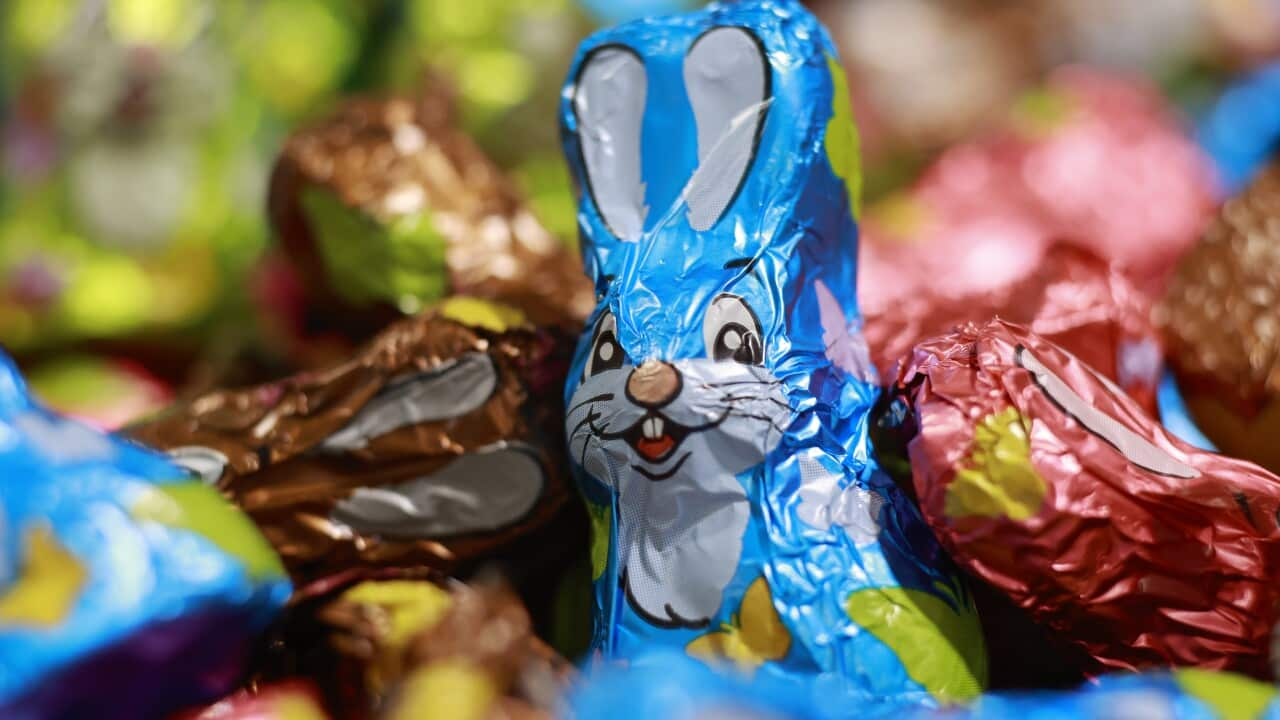A small roasting machine is whirring in the kitchen of Philippe Smets’ chocolate-making workshop in inner-west Sydney.
The 51-year-old former management consultant watches closely as raw cacao beans roll and brown inside the wire barrel.
“I buy beans from around the world, mainly from small farms,” he said. “And I make premium chocolate without additives, so it is just cacao and sugar.”
Smets is a boutique chocolate maker. But like larger producers, his business is impacted by — the raw material of chocolate.
“Buying from small farmers, this year the cacao price has gone up by about 25 per cent per kilogram,” Smets said.
“And that means for the chocolate I make, the price has to go up because 70 per cent of my chocolate bar is cacao,” he said.
Philippe Smets runs a chocolate business in Sydney. Source: SBS / Spencer Austad
Cacao prices ‘remain very high’
The price of raw cacao beans reached new records over the past year, according to Pia Piggott an analyst at Rabobank, and a specialist in food and agribusiness banking.
“Global prices remain very high,” she said. “In early February, cacao beans sold at more than $17,000 per tonne.
“However, cacao costs reached a new record in December, when prices hit just close to $20,000 per tonne.”
Earlier last year, the cacao bean price was around $7,200 per tonne, according to industry data.
Rabobank analyst Pia Piggott says the cacao bean price hikes follow three consecutive supply deficits Source: Supplied / Scott Stramyk/Rabobank
What’s been pushing up cacao prices — and how much more will chocolate cost?
The main driver of higher prices is a global shortage of cacao beans.
“Price hikes follow three consecutive deficits in supply. So, particularly in West Africa, we saw diseases such as cacao swollen-shoot virus killing many trees and significantly decreasing yields,” Piggott said.
Cacao swollen-shoot virus disease is among the most economically damaging diseases of cacao trees and accounts for up to half of all harvest losses in Ghana. This virus is transmitted by several species of mealybugs.
Recent beneficial rainfall in key cacao-producing regions of West Africa has increased tree growth, putting downward pressure on cacao prices.
Even so, experts do not expect major falls in 2025.
As Easter approaches and millions of chocolate eggs roll off production lines, retail prices are expected to lift by up to 20 per cent this year.
“As well as increasing prices, some producers are also using ‘‘, which means shrinking the size of their products,” Piggott said.
“Others are adding ingredients into their chocolate, so making them more sugary or using other ingredients that cost less than cocoa,” she said.
Ethical sourcing amid modern slavery concerns
That’s not the case for Philippe Smets, who is proud to produce pure chocolate, as one of 38 ‘bean to bar’ makers in Australia.
He performs every step by hand, from roasting and grinding to moulding and packaging.
“The ‘bean to bar’ movement started about 15 years ago in America,” he said.
“Members buy premium beans from lesser regions around the world, mainly Asia and South America, and create quality chocolate from scratch.”
Half of all cacao beans are grown in West Africa, where human rights groups report .
The United States Department of Labor estimates that 1.5 million children are engaged in child labour on cocoa farms in Ghana and Côte d’Ivoire.
For this reason, many small producers, like Smets, try to source their beans ethically. He recently traveled to Thailand to see cacao farming firsthand.
“Over several days I worked with them through the whole process of harvesting, fermenting and then drying the beans in the sun,” he said.
Philippe Smets on a recent visit to a cacao farm in Thailand. Source: Supplied / Philippe Smets
Discovering a love of chocolate after a shock diagnosis
His business, Chocolat Philippe in Sydney’s Erskineville, is a dream come true. But the idea took shape during a life-changing ordeal.
Smets vividly recalls the shock of being diagnosed with a potentially fatal illness, while working in Belgium.
“At the age of 39, I was starting a new project for a global company when I came down with a fever. At first, I thought it was the flu,” Smets said.
“But the fever did not go away, and a few days later, I was unable to walk.”
He was diagnosed with non-Hodgkin lymphoma after three days of tests while in hospital.
Non-Hodgkin lymphoma is a cancer caused by white blood cells which are part of the body’s immune system, growing out of control in the lymphatic system. The cells form growths called tumours.
“By the time I was diagnosed, it was stage four, meaning that it had spread to several organs and also to my lymph nodes,” Smets said.
“So, a very serious course of chemotherapy was needed to get rid of it,” he said.
Owner of The Deli Erskineville, Nick Vanos (left), outside his store. Source: SBS / Spencer Austad
While undergoing treatment, Smets made another discovery that would later change the course of his life.
His immune system was weakened during chemotherapy, and doctors would not allow people to bring him flowers because of the risk of germs.
“The one thing doctors allowed was eating a little chocolate,” he said.
“So, people brought me the best chocolate they could find in Belgium and that is how I discovered the taste of handcrafted premium chocolate,” he said.
After moving to Australia in 2015, with his cancer in remission, Smet’s love affair with fine chocolate flourished.
“Going back to a crazy life working in corporate didn’t align with my values. That had become clear,” he said.
“And the one thing I wanted to share with the world was the feeling of relaxation through eating fine chocolate.”
Smets has self-financed his fledgling chocolate business and hopes to buy more equipment to increase output.
His chocolate sells online and through outlets, including The Deli Erskineville.
This story was produced in collaboration with SBS Dutch.





